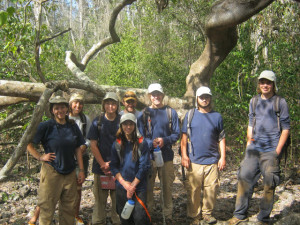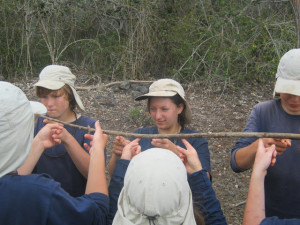 Recently, a group of the adolescent students had the opportunity to explore the rare and fascinating, two-mile loop trail at Manuka State Park. Manuka is a Natural Area Reserve, and one of the nineteen different reserves within the statewide Natural Area Reserves System. The Big Island of Hawaii island has eight reserves to call its own. Students hiked this secret jewel of Hawaiian mid to low-land native forest, that has had little human impact. The nature trail traverses over 25,550 acres of dense Ohi’a-Lehua forest. A “kipuka” is a tract of land surrounded by recent lava flow. Most forests like this have been converted into coffee farms or cattle grazing grounds, but in this kipuka is the remnants of the forests that once covered leeward Hawaii.
Recently, a group of the adolescent students had the opportunity to explore the rare and fascinating, two-mile loop trail at Manuka State Park. Manuka is a Natural Area Reserve, and one of the nineteen different reserves within the statewide Natural Area Reserves System. The Big Island of Hawaii island has eight reserves to call its own. Students hiked this secret jewel of Hawaiian mid to low-land native forest, that has had little human impact. The nature trail traverses over 25,550 acres of dense Ohi’a-Lehua forest. A “kipuka” is a tract of land surrounded by recent lava flow. Most forests like this have been converted into coffee farms or cattle grazing grounds, but in this kipuka is the remnants of the forests that once covered leeward Hawaii.
There were plenty of plants for students to identify in this kipuka, which revealed over fifty different species of native plants and many canoe plants. Hiking past the Kukui tree, an important plant brought over by Hawaiians, its branches tangled into almost artistic formations. The students split into two teams, and competed to see which team could identify the most plants on the trail. Afterwards, the group approached a pit crater, which is the aftermath of a lava flow. Some pit craters can be small, like tubes, and others can be hundreds of yards across. These craters have very delicate ecosystems, and can support life that is vastly different from creatures on the surface. Students learned about honey-creeper birds and troglodytes living down below, and the way that they adapt to a new environment. Students played a game called “choosing your own adventure”, talking about other species on the island, such as the Nene, the Hawaiian state bird and how it adapted to island life having been blown off course thousands of years ago. 
After the lesson, the group ate lunch and trekked back to the rest area, where everyone played an interactive game about bats and moths. Students learned that both the bat, and the moth adapt their behavior to feed, and not get eaten. The students really enjoyed this game, and it was great exercise! Lastly, the students came together to see if they could work as a team to lower a stick (with just two fingers placed on it) to the ground. A seemingly easy task, but hard without solid communication and teamwork. They were successful!